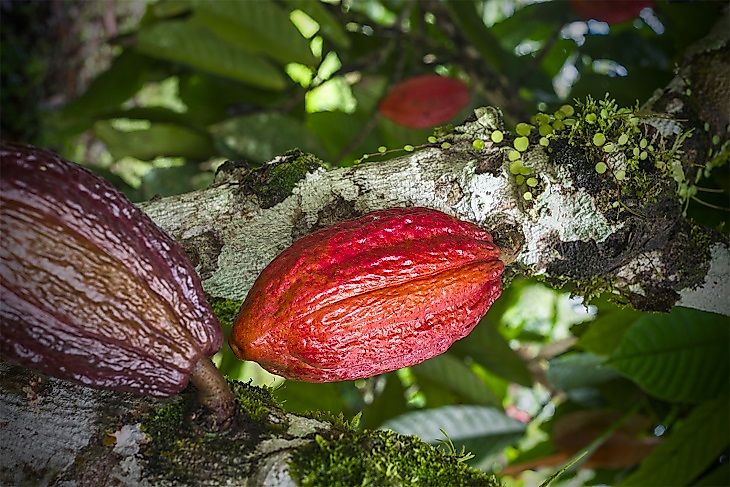What Is Cacao (The Cocoa Bean)?

Description
The cocoa bean is a seed found contained within the fruit pods that come from the cocoa tree. The pod looks like a fruit when on the cocoa tree. As they ripen, the pods turn from green (when immature) to dark brown, orange, or yellowish in color as they ripen. That color change indicates the pods are ready for picking. Once picked, the pods are then cut open, revealing the cocoa beans lined up in rows. When dried, the bean’s outer coat is brown. Besides the coat, the bean has a kernel and a germ, much like a grain seed. The cocoa bean itself is the component processed into making chocolate and other popular confectioneries.
Varieties and Growth
Cocoa trees begin bearing pods in about 3 to 4 years. Annually, a tree yields 20 to 30 pods and, according to the Cadbury confectionery company, it takes a whole year’s crop from one tree to make 450 grams (~1 pound) of chocolate. A cocoa tree bears two harvests of cocoa pods annually. Forastero, Criollo, and Trinitario are most grown and processed varieties, but there is also the Nacional variety, which takes up a significant share as well. However, it is the Forastero cacao plant variety that is responsible for 80 to 90 percent of the world's cocoa production. According to CacaoWeb, there are about 20 cocoa commercial varieties in all.
Suitable Ecological Zones For Production
Cocoa is extensively grown in West Africa, Central and South America, the Caribbean, Indonesia, and Malaysia. In order to thrive, cocoa trees require a maximum annual average temperature of 30 to 32 degrees centigrade, and a minimum average of 18 to 21 degrees centigrade, according to the International Cocoa Organization (ICO). The annual recommended rainfall for cacao growing ranges from 1,500 to 2,000 millimeters. Dry periods, where rainfall is less than 100 millimeters monthly, shouldn’t exceed three months. In cocoa-growing countries, the humidity required should be about 100 percent in the day, and 70 to 80 percent at night. Tree shading is also needed for cocoa trees, according to the ICO.
History of Cocoa
The Cocoa genus, Theobroma, can trace its origins back to the east of the Andes Mountains of South America millions of years ago. Theobroma has 22 species, of which cacao is the most known. The Maya Indians and Aztecs were believed to have discovered the viability of cocoa as an ingredient in their drinks around 400 BC. Outside of South and Central America, explorer Christopher Columbus was the first foreigner to drink cocoa, doing so in 1502. In Spain, cocoa was introduced in 1528 by Hernan Cortes an explorer, and thereafter sugar was commonly added and it became a popular drink in the Spanish courts. In the mid 1600s, cocoa began to spread into French and British territories like the Dominican Republic and Jamaica. In Africa, cocoa was introduced first in 1830 at Sao Tome and Principe, and then, from 1874 to 1879, it was introduced throughout Nigeria and Ghana, according to ICO.
Economic Value
The cocoa industry has an estimated worth of $110 billion annually. According to Fairtrade International, the worldwide demand for cocoa and derived products is expected to rise by 30 percent by as soon as the year 2020. At present, yearly 3.5 million metric tons of cocoa are produced, largely by small scale farmers, all around the world. These small farmers grow 90 percent of the worlds cocoa. The Ivory Coast, Ghana, and Indonesia are among the top cocoa growers in the world. According to the Food and Agriculture Organization, farmers who properly harvest, ferment, and dry their beans are guaranteed of achieving a higher price for their crops on the market.











